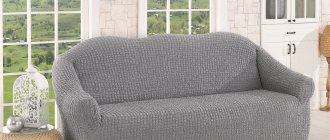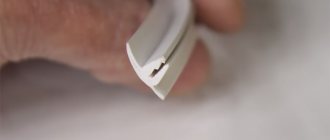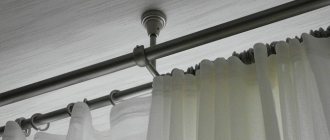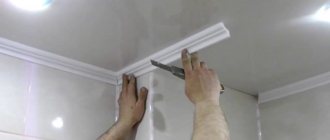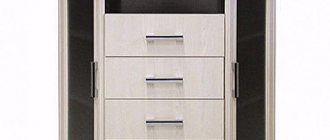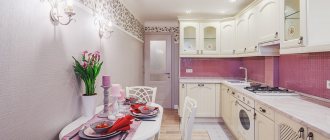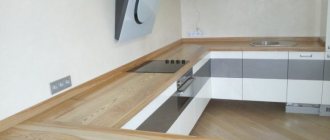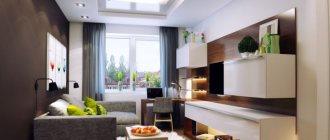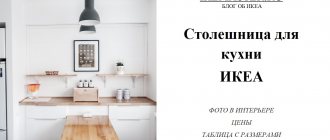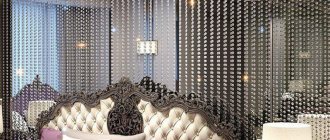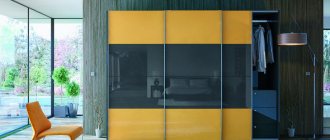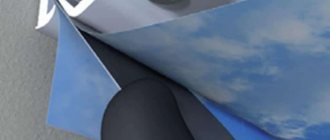Ceiling plinth is an excellent decorative element that allows you to eliminate defects that exist between the wall and ceiling and decorate the room. When installing such a plank, the ceiling takes on a complete look. Today there are a large number of options for ceiling plinths, one of which is sure to suit the decor of your room.
Types of skirting boards for ceilings
Materials used for manufacturing.
| Skirting | Description | Photo |
| Polyurethane. | Durable, elastic, bends well and is suitable for decorating even rounded surfaces. It successfully replicates stucco molding, complex ornaments and patterns, and is suitable for painting with any paints. | |
| Wood. | Made from various types of wood. Such ceiling moldings look very expensive and add aristocracy to the interior. | |
| Made from polystyrene foam. | It is characterized by low price and easy installation. The only negative is that it is very fragile and does not bend at all. | |
| PVC (polyvinyl chloride). | Durable, easy to maintain and install. Such models are easy to cut, fit perfectly and can be painted multiple times in different colors. | |
| Polystyrene. | Extruded polystyrene plinth fits perfectly to the wall and ceiling. It washes well and is also easy to paint. | |
| Duropolymer. | Eco-friendly, hard material, resistant to mechanical stress and perfect for rooms with high humidity. | |
| Plaster. | It has an exclusive, aesthetic and rich look. Gypsum models are very reliable, environmentally friendly and fire resistant. |
We focus on design
The role of fillets in interior design should not be underestimated. With the help of discreet, but noticeable elements, it is easiest to emphasize the chosen style direction. Ceiling plinth can become the finishing touch and create complete harmony.
Classic style
Interiors made in a classic style can easily be spoiled by just one detail, for example, by using a banal rubber or plastic plinth for a stretch ceiling in the decoration. For an elegant environment, elegant baguettes made of polyvinyl chloride imitating wood or exquisite stucco, or plinths made of natural wood are more suitable.
The color of the fillets should be in harmony with the rest of the finish
When choosing a color, you should focus on the general background in the interior: sharp contrasts with the decoration of the walls or ceiling are unacceptable. If it’s difficult for you to decide, give preference to white fillets. They will fit harmoniously into any interior, regardless of the shades in which it is made. Golden-colored borders with bronze or gilding will also look good - a little pretentiousness to the classics won’t hurt. When choosing a plinth for a stretch ceiling, you can first study photos of suitable solutions in catalogs.
Carved bronze borders are ideal for rooms with a classic interior
Country
The interior in a rural style focuses on the naturalness of materials and suggests the use of wooden decorative elements as accents. And then the optimal choice would be plinths for a stretch ceiling made of natural wood, but a high-quality imitation of this material will also do. The interior design will be complemented by carefully selected fastener elements - they can be made in the same style, representing metal strips with a touch of patina, or imitate carpet any details.
Wood fillets will organically replace analogues that imitate natural material
Modern
The expression of this stylistic direction implies a predominance of curves and roundness. In the interior, it will look good to have wide and flexible skirting boards that can carefully wrap around any curve. An excellent option is the choice of flexible polyurethane fillets with a relief pattern in the form of floral designs. Modern loves the play of light, so a plinth with additional lighting around the perimeter of the ceiling will provide soft contour lighting.
The presence of many roundings places special demands on the flexibility of fillets
Modern style
Functionality and conciseness - this is how you can characterize the requirements for choosing skirting boards for rooms whose interior is made in a modern style. Pretentiousness and luxury are not inherent in it, and then the best option would be simple skirting boards with a smooth surface without relief patterns. Both polyurethane products and cheaper analogues - for example, made of polystyrene foam - are suitable.
The cost does not matter - the main thing is that the plinth does not stand out from the general style
Varieties of skirting board textures
The main types that are classified according to texture parameters:
- Smooth. It has a flat, smooth surface, without indentations, patterns or ornaments. It looks discreet and is great for decorating almost any interior.
- Extruded. It is distinguished by longitudinal recesses with ready-made grooves.
- Injection. It has a convex relief surface and has a granular structure. Such ceiling fillets are an independent decoration.
The photo shows an injection ceiling fillet in a beige shade.
What sizes are there?
There are two main types: wide and narrow. Other tips for choosing the size will be listed below.
Narrow
Size range from 10 to 50 mm. Thin, laconic fillets are suitable for small rooms with low ceilings.
Wide
Allows you to visually smooth out corners and hide imperfections and unevenness of the walls. It has a range from 160 to 350 mm, and is most often used for decorating spacious rooms.
Varieties of fillet shapes
There are several types:
- Straight. The traditional and most common option, which is found in almost any interior.
- Flexible (soft). Such radius baguettes allow you to organize smooth shapes, thereby hiding imperfections, crooked corners and flaws in the ceiling space.
- With cable channel. They have additional internal space in which you can hide wires.
Each of the listed forms carries a certain focus and functionality.
What color are the skirting boards?
Colored fillets change the overall perception of the interior and the room as a whole. In addition, ceiling plinths can be painted independently in any color.
- White.
- Black.
- Gold.
- Brown.
- Beige.
- Grey.
- Chromium.
- Yellow.
- Blue.
- Green.
The photo shows a narrow yellow ceiling fillet in the dining room interior.
To visually expand the space, use baguettes that match the color of the ceiling; to increase the height of the room, use ceiling plinths that match the color of the walls.
Comments
No comments yet
Please log in to post a comment.
Gone are the days when they used everything as a ceiling plinth: gypsum, wood, paper tape with an ornament... Of course, gypsum and wood are successfully used to this day, however, the types of materials for this much-needed finishing attribute have become noticeable more: plastic, foam plastic, polyurethane...Even floor skirting boards are used for this purpose. However, it is the polyurethane plinth for the ceiling that is, at times, almost the only solution, due to its exceptional flexibility, which other materials do not have to the same extent.
Design options and drawings
A huge variety of decor gives baguettes a more unique look.
- Stucco molding. Always looks expensive and respectable. It brings notes of antiquity and luxury with its appearance and is best combined with classic interiors.
- With inserts. Inserts can be made in various colors, for example white and gold or dark wenge and silver. They are selected in combination with the color of the ceiling or walls.
- Patterns and ornaments. They transform and enliven the ceiling space, deprive it of monotony and set a unified style for the room.
- Ladder. The original cross-section in the form of a ladder creates a stepped ledge, which is quite popular in the design of many interiors.
The photo shows a white wide ceiling molding in the shape of a ladder.
Baguettes with a variety of designs harmonize the decor, give the room a special character and simply look very impressive.
Combination with baguette
The plinth runs throughout the room and is adjacent to the baguette, so it is important that they combine harmoniously with each other. The easiest way is to use a white baguette. It is ideal for the living room, kitchen, hallway, bedroom and always looks neat and original.
If you didn’t manage to choose a color the first time, don’t despair. You can always repaint the baseboard and change the perception of the room.
For what types of ceilings can decorative skirting boards be used?
The main types of ceiling coverings to which fillets are applied:
- Stretch ceiling. Such a plinth not only protects and hides cracks and gaps between the walls and ceiling, but is also a rather original element of decorative finishing.
- Suspended ceiling made of plasterboard. For plasterboard two-level or multi-level structures, almost any model will be appropriate. Skirting boards made of polyurethane or polystyrene look especially natural with suspended ceilings.
- Wooden clapboard ceiling. Wooden figured and carved fillets in combination with the identical texture of the ceiling look luxurious and are in perfect harmony with each other.
- PVC panels. Plastic baguettes are better suited here, as they will noticeably highlight and emphasize the design of the entire ceiling.
- Ceiling tiles. Skirting boards will not only complete the overall design, but will also greatly simplify the gluing of ceiling tiles along the edge of the ceiling.
The photo shows a wooden openwork baguette in combination with ceiling lining.
Such models create a single composition on the ceiling and an additional geometric effect.
The photo shows a two-level plasterboard ceiling structure with polystyrene baguettes.
Floor wall skirting boards for the kitchen
Kitchen floor plinth is a decorative element that hides the junction of the wall and the floor. This is a triangular or rectangular strip with internal grooves or longitudinal grooves and ornaments. There are also models in the form of a flat rail. It can be solid or hollow, allowing you to hide the wires inside.
The wall plinth for the kitchen visually connects the walls of the room with the floor, creating an integral composition.
Depending on the type of flooring, the material for the plinth is chosen. Its different types have advantages and disadvantages and have installation features.
Plastic
Plastic products are combined with floors covered with artificial materials, for example, linoleum , laminate , carpet.
The upper and lower edges of such skirting boards are rubberized. This allows you to achieve a tighter fit to the floor and wall.
If the walls are uneven, the baseboard will not hide this defect or even emphasize it. Try filling the gaps between the wall and the trim with colored laminate sealant in a matching tone.
Plastic is not afraid of moisture, as well as household chemicals. It is lightweight and flexible and does not require painting or sanding. Such a plinth should be protected from strong impacts; cracks and chips may remain.
Options with a cable channel are common. They can hide from one to six wires, depending on their type.
There are models suitable for framing radial rooms. This plinth is heated and bent to the shape of the wall, then attached. After cooling it hardens.
Important ! It is not recommended to heat plastic products to temperatures above 60°C to avoid the release of toxic substances.
The plastic plinth is installed on a mounting rail or clips. The base is fixed to the wall with self-tapping screws, and the decorative part is inserted or snapped into it.
Plugs and connecting elements can cause inconvenience. They are installed in corners, at joints, and at the ends of the planks. They fly out if they are not securely fastened and reduce the aesthetic appearance. For additional fixation of parts, use transparent glue.
Some types of plastic are sensitive to ultraviolet light. Under its influence, they turn yellow or crack over time.
Polyurethane
Polyurethane is suitable when used with synthetic coatings. Products made from it are rigid and flexible, and are used both for rooms of regular shape and for non-linear ones.
Immune to water and temperature changes. Afraid of alcohol solvents.
Skirting boards are also equipped with niches for wiring.
The material is susceptible to the formation of static electricity and attracts dust. If you paint with water-based paint, the problem will be solved.
Mounted with special glue. It may shrink after installation, forming tears at the joints.
Tree
For wood or parquet floors, a wooden baseboard is suitable. It can be solid, glued or veneered.
Wood products are durable, environmentally friendly, but not resistant to moisture. In the kitchen there is a risk of fungus and insect infestation.
You can hide wires only behind some models.
Wooden planks are glued to the walls, secured with screws or studs. Treatment with varnish or paint is required. The coating requires updating periodically.
MDF
MDF (chipboard) plinths are also used with non-natural floor coverings or in combination with walls finished with MDF panels.
The material is laminated or veneered with natural wood. It is moisture resistant, not afraid of the sun, and easy to clean. Physical impact can leave dents on the baseboard or damage the coating.
The products are equipped with holes for cables.
The MDF plinth is glued or attached to mounting brackets screwed to the wall with self-tapping screws. Working with MDF, especially sawing, leaves behind a lot of dust.
Ceramic tile
Ceramic tiles for baseboards are only used in combination with tiled floors.
The properties of the tile are ideal for the kitchen: it is not afraid of water, chemicals, heat, light, and is easy to maintain.
The wiring will not be hidden under the ceramic border.
Installation takes place using conventional tile laying technology:
- the walls are cleaned and primed;
- apply tile adhesive with a spatula;
- install plinth;
- After drying, the seams are rubbed.
For the border, sawn tiles or ready-made options from the same collection with floor coverings are used.
Decorative rock
Stone skirting boards can be made of natural stone (marble, granite, onyx, limestone) or artificial (acrylic). It is advisable to use them in rooms with stone floors.
The material has increased strength, moisture resistance, and is easy to clean.
Natural stone products are attached to tile adhesive. Acrylic skirting boards are installed using seamless technology using silicone glue, the joints are filled with a special glue for artificial stone. It is usually not possible to hide wires and cables in a stone curb.
Photos in the interior of the rooms
Baguettes can become an indispensable and main decoration of any room.
Bathroom
Galleys allow you to beautifully decorate your bathroom, give it the desired appearance or set the style.
Kitchen
Classic simple ceiling models made of polyurethane or polystyrene, which are resistant to high humidity and are easy to clean, would be appropriate here. It is advisable to choose wooden skirting boards for the kitchen without unnecessary patterns and ornaments.
Living room
Baguettes can completely change the interior of the living room, create unusual color and shade combinations and simply decorate the ceiling space.
The photo shows a small room with ash-colored ceiling moldings.
Balcony
To decorate a small balcony, narrow baguettes are suitable, which will visually balance and balance the narrow space.
Children's
Properly selected baseboard colors will allow you to create a harmonious design for the nursery, create smooth color transitions on the ceiling and thereby add additional height to the room.
Choice of baguette color
Choosing the right color for skirting boards is not as easy as it might seem at first glance. If the ceiling and walls are finished in the same shade, then the planks should differ from them in color in order to delimit the surfaces and not merge with them. If you can’t choose any shade to match the interior of the room, then you should choose a white ceiling plinth in the interior - it is universal (about
A selection of photos of skirting boards in various styles
A wide variety of models and decor allows you to choose an option for a room with any style direction.
Modern
Models of a simple shape with simple lines will look especially organic in this style. Thanks to their versatility and huge selection, they will allow you to create a stylish and modern design.
Classical
Plaster, wooden or polyurethane skirting boards with carved patterns, stucco or gilding are perfect for interiors designed in a classic style.
Loft
This style does not involve intricate decoration. Light fillets with a simple and laconic design are suitable here.
The photo shows a wide white ceiling fillet in a loft-style bedroom.
High tech
Skirting boards with clear lines and shapes, smooth, decorated with lighting, will look unusual and emphasize the futuristic and fantasy interior.
Minimalism
Thin baguettes with a discreet design, made in discreet colors, will harmoniously resonate with the rest of the minimalist decor, and will not attract unnecessary attention.
Scandinavian
White fillets without frills would be especially appropriate here, emphasizing the restraint and coldness of the Nordic style.
The photo shows a white ceiling fillet in a Scandinavian-style living room.
Original design solutions
“The LED strip in the ceiling plinth can be located in different parts, so it can illuminate the walls, ceiling or general space”
Wide baseboard in the bathroom interior
You can create original decor even with a simple baseboard. Let's see how this can be done without much effort.
Fillets with hidden lighting
Wide plinth in the design of a modern nursery
Manufacturers have begun to produce options with a special groove where LED strips can be placed. As an interesting solution, you can choose a plinth with a matte diffused cap.
The LED strip in the ceiling plinth can be located in different parts, so it can illuminate the walls, ceiling or general space. If it is necessary to illuminate the ceiling space, then the fillet is attached 20 cm below the line of junction with the walls.
Skirting boards with a colored pattern look original
The materials used are PVC, foam plastic, polyurethane or wood. The LED strip serves as a complement to a chandelier or other main source of lighting.
Options with different lighting
In addition to white, there are skirting boards:
- golden;
- black;
- green;
- blue;
- brown;
- chrome plated (glossy);
- beige;
- yellow.
The width of the plinth is chosen in accordance with the design of the room
In addition to the colors available in the store, customers can independently create the desired color and apply it to the surface, and if they don’t like it or get tired of it, paint it again. An original solution is considered to be skirting boards with voluminous prints, painted in a different tone from the main color. Such fillets fit well into rooms with a simple interior, otherwise they can attract attention and ripple.
Illuminated skirting board ideas
The LED strip gives the baguettes an even more original and unique look. This lighting goes well with other lighting fixtures, such as a chandelier, sconce or spotlights.
The photo shows a children's room with a wide ceiling molding decorated with lighting.
Examples for non-standard ceilings
The functionality of skirting boards makes it possible to use them even in non-standard solutions.
Two-level
On such a ceiling, baguettes look especially beautiful. In addition, they allow you to hide transitions between levels.
The photo shows a two-level ceiling structure, decorated with wide plinths.
Sloping ceiling
Skirting boards for a sloping ceiling on the attic floor in a country house or wooden house must be flexible in order to neatly frame numerous corners in the room.
Rounded
Radius fillets are perfect for rounded ceilings. Such elastic models will easily allow you to decorate semicircular corners without unnecessary problems.
What is a shame for an oligarch, is savings for an ordinary person
There is no point in resorting to refinements when decorating an ordinary apartment in a Khrushchev-era building or a small house. Limited space, low ceilings, poor lighting, minimal opportunities for the designer to work. We must not forget about the desire of the owners of such real estate to fit into rather meager budgets. All these features require a very flexible attitude to the choice of building materials and finishing elements.
When buying skirting boards for the floor, you can purchase planks from the same Ultrawood collection, which will look good as fillets. Many developments of the American company are characterized by versatility and can be installed in non-standard places.
In particular, the baseboard Base 014, Base 002 or Base 5573 belongs to this type. It looks great on both the floor and ceiling. The products have excellent performance properties:
- easy to paint in any color;
- do not require practically any maintenance (the owner will only have to wipe its surface from dust once a year);
- do not emit harmful volatile substances;
- do not become a “home” for fungi and mold.
When purchasing an inexpensive baseboard, the cost of subsequent installation may be included in the price of the product if a person purchases a large batch. This fact has made Ultrawood profiles especially popular among officials supervising wholesale government procurement and representatives of societies of co-owners of apartment buildings.
How to choose a ceiling fillet?
A few recommendations for choosing a ceiling molding:
- The fillets should preferably be combined with the color of the ceiling or walls. This way you can create a more cohesive composition.
- Wide ceiling moldings hide defects and imperfections in the room well.
- For low ceilings, you should not use bulky skirting boards, as they visually hide the height of the room.
Table of correspondence between room size and baseboard width
Correct size ratio.
| Room height | Recommended skirting board width |
| Less than 2.5 m | Up to 40 mm |
| 2.5 - 3 m | No wider than 70 mm |
| More than 3 m | 80 mm or more |
| Narrow and high rooms | 70 mm + molding |
Installation of baseboard moldings on a ceiling base
Installing skirting boards on the ceiling is a responsible operation, an error in which can result in loss of the effect of finishing the room as a whole, since the ceiling is more open to view than the floor.
Therefore, when installing fillets, all of the following components of this procedure are equally important:
- marking the base;
- cutting skirting boards into fragments;
- fastening moldings to the base;
- sealing joints between fragments;
- painting the mounted contour.
There is no universal technology for installing skirting boards on the ceiling, since the installation method depends on a number of factors, including:
- method of finishing the ceiling base;
- molding material;
- fillet designs;
- design functionality of the plinth contour.
One of the components of laying ceiling plinths is cutting fillets to size, taking into account the angle of joining of adjacent fragments, regardless of the material of the products and can be considered as common for installing all types of moldings.
